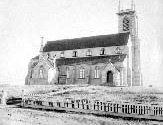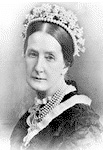
| Introduction | Victorian Childhood | Philanthropy | BC Protestant Orphans' Home | References | Site Information |
A Brief History
Victorian Philanthropy
Religious Motive
Women and Philanthropy
PHILANTHROPY
A Brief HistoryIn the period between the fall of the Roman Empire and the
enactment of the first Elizabethan Poor Law in 1601 philanthropy was
characterized by various hierarchical relationships within the feudal
structure. Help for others was preeminently a matter of royal
contributions, but was also greatly supplemented by personal charity on
the part of the wealthy. Religion and concerns about life after death
drove many to charitable works. Churches continually increased
their position in society and began to take a prominent role in
philanthropic endeavors. Over time the church’s role evolved,
becoming one of the main instruments of charitable actions. A
wide range of personal motivations contributed to philanthropic
participation, as helping others was seen as emotionally and socially
stimulating. While much was accomplished in this period, charity was
often erratic and did not always fully meet the needs of the recipients. [1]
Victorian Philanthropy
Philanthropy can be defined as the provision of financial, material,
and ideal resources for cultural, social, and educational
institutions. During the course the 19th century these aims
increasingly came to fruition through foundations, limited dividend
companies, membership organizations, or by bequests and donations, and
were generally facilitated by middle to upper class people.[2]
Charity organization movements were one of the key characteristics of
Victorian era philanthropists. With the emergence of nation states
prior to and during this period, poverty and social welfare gradually
became embodied in law. State advocated reform was often frenzied,
highly bureaucratic, and humiliating to the poor who received
aid. However, as the duties of governments increased, aid
societies and philanthropists also expanded their organizational
efforts. Civil and religious structures for taking care of the
poor began to mix, resulting in a more bureaucratic and regimented
approach to philanthropy.[3] Social sciences began to be
consulted more as philanthropists and the state sought to identify and
subdivide social problems, and to obtain information on specific needs
that would remedy the identified problems. The inclusion of
social science in social welfare organizations helped to make
philanthropic endeavors more efficient.[4]
Religious Motive in 19th Century Philanthropy
Philanthropy in the 19th century was based on religious
tradition that was centuries in the making. Historically, wealthy
people in society gave to the poor as a Christian duty. Charity
was seen as a way of saving one’s own soul while also helping
those in need. Protestants, especially those with strong
evangelical leanings, believed that social conscience demanded social
action. They held that by coming into contact with human nature,
particularly with those in need, that they were able to come in contact
with Christ.[5] Religious philanthropists believed that by
helping the needy, they were helping their own kin because everyone was
a child of God. Good works were, and are part of the foundation of
Christianity, and pave the way to salvation. Through the 19th
century, the church increasingly became the vehicle of private and
public social work. However, it should be noted that though
philanthropy was rooted in religious and church tradition, it also
spread outside the church. Philanthropy and religion are
intertwined throughout history, but are not necessarily dependent on
each other.
Women and Philanthropy in the 19th Century
The growth of the middle classes in the 18th and 19th
centuries gave rise to increased public participation on the part of
women. Work in charitable groups and institutions became an
avenue for entry into elite society for women and gave them a sense of
place and direction outside the home. By the 19th century women
were increasingly better educated, and viewed by some aspects of
society as an underutilized resource. Philanthropic work was seen
as the ideal situation for the inclusion of women because charity work
seemed to be a natural extension of their maternal qualities into
wider society. A distinctive feature of women’s
philanthropic work in the 19th century is the degree to which they
applied their domestic experience and education outside the home. The
saying “charity begins at home” had wider meaning than
it’s originator suspected for it was believed that it was in the
home where women developed the sympathies and skills necessary to
perform good works in a wider sphere. As the family received more
and more attention as the paramount social unit in society, women,
believed to be the natural guardians of the household, gained new
confidence. [6]
The rise of evangelism in the 19th century also contributed greatly to
women’s expanding roles in institutional philanthropy. As a
religion of duty which placed service above doctrine, evangelism
particularly appealed to women as religious sensibility and social pity
stood much higher in their minds than abstract arid theology. [7]
Women’s industriousness in household management also
proved to be beneficial for the often cash-strapped
organizations. In addition to fundraising through bazaars, dinner
parties, banquets, and collection boxes women took on extra household
work, and sold handiworks to earn extra cash for their organizations.
Women brought a caring and industrious influence to institutional and
private philanthropy that may have been lacking had philanthropic work
been left solely to their male counterparts.
Sources
1. Robert Morris, Rethinking Social Welfare: Why care for a Stranger? (New York: Longman Inc., 1986), 117-119.
2. Thomas Adam, “Philanthropic Landmarks: The Toronto Trail from a Comparative Perspective, 1870’s to the 1930’s” Urban History Review October 2001, vol. 30(1), 3-5.
3. Morris, Rethinking Social Welfare, 119-120.
4. F.K. Prochaska, Women and Philanthropy in Nineteenth-Century England (London: Clarendon Press, 1980), 133.
5. Henry B. Washburn, The Religious Motive in Philanthropy (New York: Books for Library Press, 1931), 8-20.
6. Prochaska, Women and Philanthropy, 5-8.
7. Prochaska, Women and Philanthropy, 10.
top of page

The Iron Church in Victoria, a gift from Angela Burdett-Coutts
(BC Archives A-02788)
top of page

Christ Church Cathedral
(BC Archives B-02806)
top of page

Baroness Angela Burdett Coutts
(BC Archives B-00713)
top of page
top of page
© 2007 All Rights Reserved
[HOME] [VICTORIAN CHILDHOOD] [PHILANTHROPY] [ORPHANS' HOME] [REFERENCES] [SITE INFO]